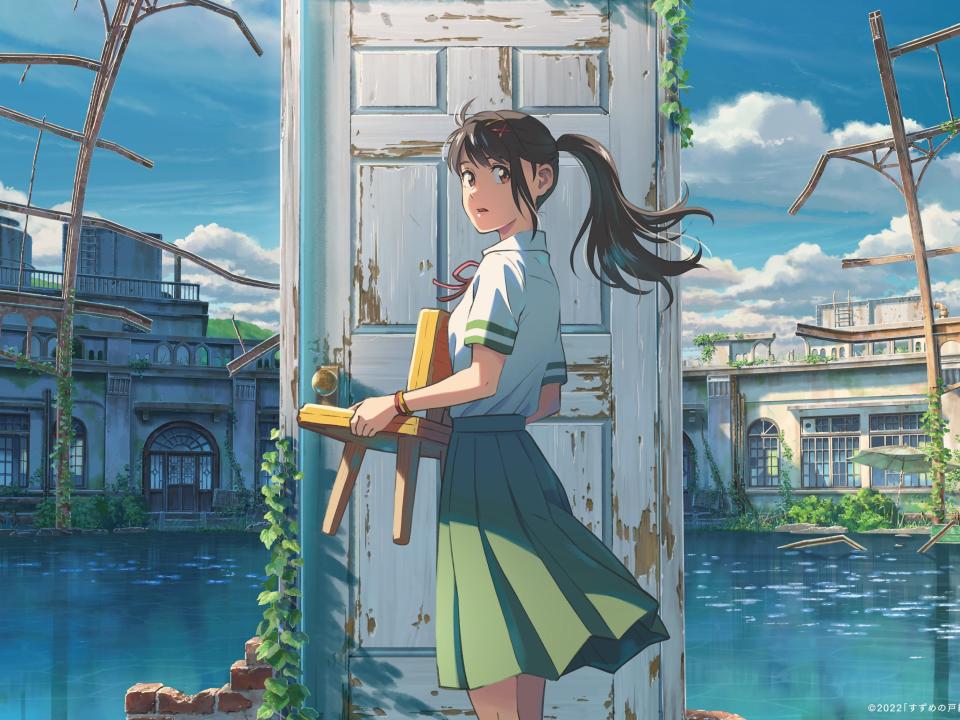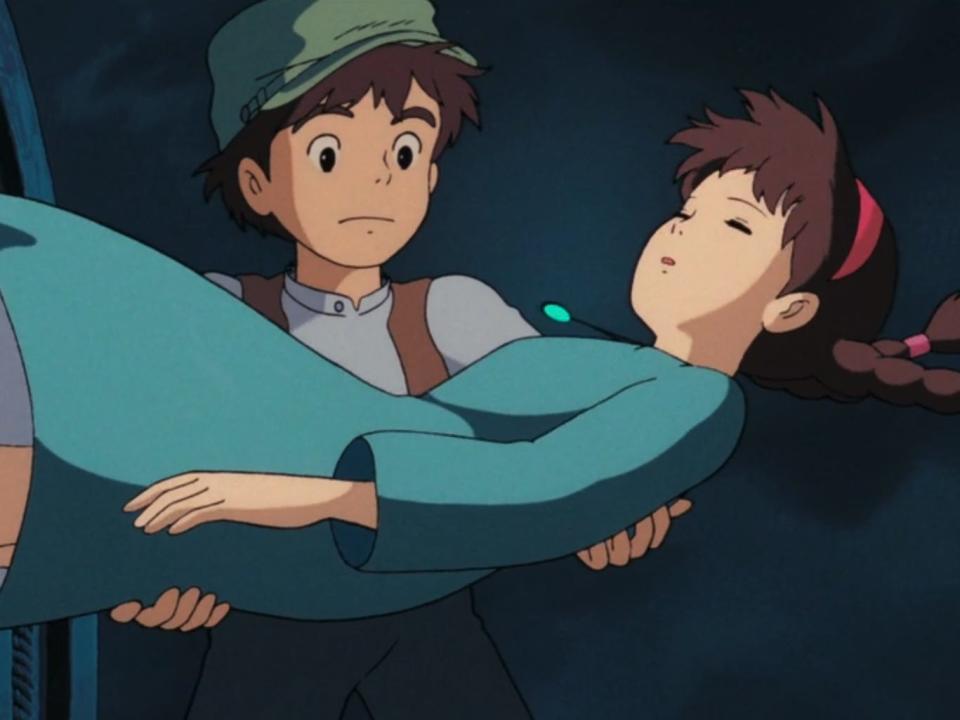'Suzume' director Makoto Shinkai is 'a little exhausted' by the constant comparisons to Studio Ghibli legend Hayao Miyazaki

Makoto Shinkai's latest film "Suzume" addresses the legacy of the 2011 Great East Japan Earthquake.
BI spoke with Shinkai about "Suzume" and his prior films "Your Name" and "Weathering With You."
Shinkai spoke about his process and how years of Hayao Miyazaki comparisons have left him "a little exhausted."
"The Director's Chair" is a series highlighting those at the helm of the biggest projects in TV and movies.
Acclaimed filmmaker Makoto Shinkai's latest film "Suzume" is perhaps the most keen film in the director's trilogy of coming-of-age disaster films.
Though, to call Shinkai's work "disaster films" is a bit reductive. The 51-year-old director, who grew up in the small town of Koumi and now lives in Tokyo, Japan, got his start as a video game animator in the 1990s before releasing his first feature film "The Place Promised in Our Early Days" in 2004 on the heels of two acclaimed short films. His three most recent works — "Your Name" (2016), "Weathering With You" (2019), and "Suzume" (2022) — all hinge on supernaturally tinged natural disasters. But these three Shinkai films are really about the impossible choices young people face during daunting circumstances.
"Suzume" was inspired by, and directly grapples with, the devastating 2011 Tohoku earthquake (sometimes referred to as the Great East Japan Earthquake) that resulted in nearly 20,000 deaths. In it, Shinkai wields whimsy and grief in equal measure as Suzume, a survivor of the 2011 earthquake herself, travels across Japan closing supernatural doors that keep a chaos-causing creature at bay after Souta, a university student who would normally be responsible for locking up, gets stuck in the body of Suzume's three-legged childhood chair.
"Suzume," which was previously released in US theaters in 2023 and available to stream exclusively on Crunchyroll, is now streaming on Netflix. Business Insider spoke with Shinkai about the deeply moving — and frequently very funny — coming-of-age story, as well as his filmmaking process and feeling a bit "exhausted" by comparisons to a fellow titan of Japanese animation, Hayao Miyazaki, when the film premiered stateside last year.

'Suzume' is the first time Shinkai directly grapples with the Great Eastern Japan Earthquake of 2011, but his earlier films were also influenced by the disaster
According to Shinkai, disasters started making their way into his stories of their own accord.
"When I set out to make 'Your Name' or 'Weathering With You,' it wasn't the mindset of, 'I'm gonna make a disaster movie now,'" the director told BI. "I wanted to tell a story and show Japan in its current state. And it's almost as if the disaster started making its way into my story and screenplay."
Responses to those films helped to shape Shinkai's approach to "Suzume," though he found some criticism rather surprising.
"Your Name" features two teens — Taki and Mitsuha — who spontaneously start swapping bodies. Eventually, they discover that they're separated not only by space, but time as well: In the future Taki inhabits, Mitsuha was killed by an asteroid that impacted her rural hometown. Impossibly, their connection manages to rewrite the disaster, saving her life and that of her townspeople.

The film is one of the highest-grossing anime films of all time ("A lot of people enjoyed it," Shinkai noted modestly), but that didn't mean it averted criticism.
"People thought I was almost denying this massive disaster or tragedy, and trying to cancel Mitsuha's death and rewrite history as though this disaster never happened," he told BI. "To me, that feedback was rather shocking because I came from a place of genuinely wanting Mitsuha to be safe."
"Weathering With You," Shinkai's 2019 film, swings in the other direction, leaning into disaster rather than trying to avert it. Hina, a "sunshine girl" with the ability to stop the heavy rains plaguing Tokyo, effectively sacrifices herself to clear the skies. But Hodaka, a boy who befriended Hina in the city, drags Hina back down to earth at the expense of condemning the city to flood.

"Weathering With You" is poignant climate crisis commentary, and Shinkai told BI that he approached the film believing that people would relate to the fact that climate change isn't a responsibility that can land on one person's shoulders. Criticism that people couldn't relate to Hodaka's "very selfish" choice was a "shock" to the director, but also an indication that "the social fabric runs really, really deep."
The director told BI that he took those criticisms into account when approaching "Suzume," the most singularly focused of the three stories. The film, which was first released in Japan in November 2022 and became one of the highest-grossing anime movies of all time even before its international theatrical release in April, makes no attempt to rewrite history. Rather, it contextualizes an immeasurable amount of grief over the thousands lost in the 2011 disaster within one girl finding her desire to live years in the aftermath.

"I didn't really want to make a movie about the sort of current events or struggles of the younger generations in the context of their social confines," the director told BI. "I tried to recall or recollect my own memories when I was going through puberty and when I was an adolescent, that anxiety and fear that I would feel. I would tap into that."
Shinkai is an auteur with his own signature style, and while he's flattered by the Miyazaki comparisons, he's also a bit tired of them
When making a film like "Suzume" or "Your Name," Shinkai sits down, writes a script, and then storyboards and records a dialogue track himself in order to "tweak" what he's written. Some directors or writers may be able to envision their words being spoken, Shinkai told BI, but he's not one of them. Thus he has to go through the process of "writing on paper what I imagine, and then passing it through myself as a voice."

That meticulous approach and his signature "Shinkai-style" of vivid colors, lens flare, stunning cityscapes, and shining natural features like the rain of "Weathering With You," have established him as one of the foremost Japanese animators and directors of the current moment. That status, which he's held for well over a decade, has often led to comparisons to the legendary director Hayao Miyazaki — something that Shinkai noted in an interview with Fandom happens more in countries outside of Asia, where Miyazaki is still "one of the first names" to surface on the subject of animation.
"The comparisons and juxtapositions between myself and Miyazaki have been something that's followed me around for the last 10 years," Shinkai told BI. "And as flattered and honored as I am to hear those comparisons, I think a part of me is almost a little exhausted from hearing it as well. Because in my mind, as a huge admirer of Miyazaki's work, I feel what he does is something only he can do."
There are some thematic similarities between their work: Both directors have frequently honed in on coming-of-age stories mired in whimsy and the supernatural, and Shinkai has repeatedly gone on the record about being inspired by films like Miyazaki's "Castle in the Sky" (1986) or "Kiki's Delivery Service" (1990). Still, they're products of different generations, Shinkai told BI — Miyazaki from a "so-called golden age" of Japan, and Shinkai from a Japan that was "almost in decline both economically and population-wise."

And while there are things that only Miyazaki can do, there are others that only Shinkai can do as well. The manner in which he evokes the profound grief of the 2011 earthquake in "Suzume" — and the ways in which he tackles big topics like climate change through the lens of impassioned young people — also feels singular.
Ultimately, the biggest responsibility that Shinkai feels isn't carrying the torch of Japanese animation worldwide, or living up to the reputation of his predecessors. It's to his audience.
"I think there's this obligation to do more than simply provide two hours of entertainment," Shinkai told BI. "There has to be some other kind of value add I can provide within the context of the story. And I think that thought process and cycle is ultimately what led me to creating 'Suzume.'"
Read the original article on Business Insider

 Yahoo Sports
Yahoo Sports 
